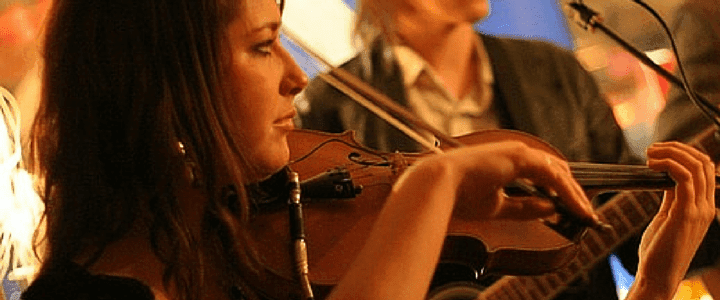Are you looking for more information about the Suzuki violin method? Below, we’ll go into detail about everything you need to know about the Suzuki method, including its pros, cons, and everything in between for students and their families.
The Suzuki violin method can be a polarizing topic in the music world, as there are many different opinions surrounding it. While some argue that the method helps children develop a high level of playing ability, others say it doesn’t teach students proper violin techniques.
If you’re considering the Suzuki violin method, it’s best to thoroughly research it before you determine if it’s a good fit for you or your child. To ensure you have all the necessary information to make an informed decision, we provided six principles of the Suzuki method along with their pros and cons.
What is the Suzuki Violin Method?
The Suzuki violin method is a specific musical curriculum that was developed over fifty years ago by Japanese violinist, Shinichi Suzuki. After the devastation of World War II in his home country Japan, Suzuki was looking for a way to bring joy and happiness to the children. He noticed how easily kids learn their native language and figured the same principles applied to teaching them how to speak would translate into other aspects of life—specifically, navigating how to play a classic violin.
Suzuki developed a philosophy based on a few key beliefs, including saturation in the musical community, deliberate avoidance of musical tests or auditions, and focus on playing from an early age. It also involved using well-trained instructors, memorizing solo repertoire, learning music by ear before reading it, regular playing in groups, and more.
Now that you better understand the Suzuki violin method, let’s dive into the five techniques.
The Five Techniques of the Suzuki Method
The Suzuki violin method includes five techniques developed for young musicians:
- Tonalization: A play on the word “vocalization,” Suzuki developed this as a way for a student to recognize and produce a ringing, beautiful tone from their violin.
- Sound recordings: Listening to one’s own music and others’ music is a teaching technique that has been around for years. But in this case, the emphasis and scale in which recordings are listened to in the home begin before the child is even born.
- Adapted instruments: Instruments are adapted to fit the physiological requirements of a small child’s body. This enables children to begin their learning at an even earlier age.
- Suzuki Institutes: Suzuki established these as places for students, teachers, and parents to share and expand on their ideas in a central location.
- Common repertoire: This particular technique allows students to participate in group classes and provides motivation for them to learn new music while keeping the “traditional” musical pieces they’ve learned in their best form.
Suzuki Method: The Pros & Cons
1. Structure of the Suzuki Method
Suzuki violin programs are a mix of group and private violin lessons. Below are the pros and cons of this structure.
- Pros: Students receive frequent reinforcement of skills because they are attending at least two lessons per week. The varied lesson plans provide a well-rounded approach, covering many different learning styles. Group lessons are also a great environment for children to be encouraged and challenged by their peers.
- Cons: The lesson commitment for the Suzuki violin method is more than that of traditional private lessons, which can be too much for today’s busy families. Additionally, the Suzuki structure is pretty regimented, without much flexibility for missed lessons.
2. Listening to Violin Music
Students are encouraged to listen to violin music daily, especially recordings of the songs they are learning in lessons. This requirement of the Suzuki method comes with its own set of pros and cons as well.
- Pro: Listening to music daily is a fantastic way for children to develop an ear for the violin and other instruments. The more they listen to the songs they are learning, the faster and better they will learn those songs.
- Con: The commitment to listen to music daily typically falls on the child’s parents. Not only is this a burden on busy families, but some parents will quickly grow tired of listening to the same Suzuki violin songs day in and day out.
3. Performances and Recitals
Recitals play an important role in the Suzuki violin method, which also has advantages and disadvantages for families.
- Pro: Preparing for a recital gives students a goal to aim for. Students are often proud of their accomplishments after a recital, which is a great self-esteem builder. Suzuki recitals with group performances also provide a safe performance environment for new violinists.
- Con: Children who are very shy may have a hard time with this aspect of the Suzuki violin program. It can take a while before a student feels comfortable enough to go on stage and showcase his or her skills.
4. Rote or Memory Learning in the Suzuki Method
Beginner students learn songs by rote (or memory) in the Suzuki method. Note reading is finally introduced several years later into the program.
- Pro: Students develop excellent ears, meaning they can hear whether or not they are playing in tune. Songs become very strongly ingrained in their minds because everything is played by memory. Students who struggle with note reading will find great freedom in playing music without reading notes.
- Con: Because note reading is not introduced until later in the program, it can often be a struggle for students. By the time they learn how to properly read music, their violin techniques are much more advanced. Going back to the basics can be frustrating, not to mention difficult for students who might have already developed bad habits.
5. Practice Commitment
Daily practice is expected when learning the violin with the Suzuki method. Here are the advantages and disadvantages of this factor.
- Pro: Any student who practices an instrument daily, even for 10 minutes a day, will make significant progress. After all, daily practice is one of the best ways to improve upon one’s skills. With this in mind, the Suzuki method is excellent for making regular practice a necessity.
- Con: As parents are well aware, most children will not practice unless they are told to. A lot of responsibility for the daily practice sessions will fall on the parents, which can quickly become a burden or cause friction in the family.
6. Parental Involvement in the Suzuki Method
With the Suzuki method, parents are expected to learn the violin alongside their child. This means attending all lessons and classes and directing practice sessions at home.
- Pro: Young children benefit greatly from having such strong parental involvement. This is especially clear with the parent-directed practice sessions at home. The focus and assistance that parents provide during these sessions ensures that students are reinforcing the skills they learned during their violin lessons.
- Con: The Suzuki violin program is a sizable commitment for parents. In addition to attending lessons and directing daily practice, parents must carve out significant time in their schedule to learn the instrument themselves. Not only does learning an instrument take time and patience, but it can also be difficult to master as an adult.
As you can see, there are many great aspects of the Suzuki violin method. The cons are largely circumstantial and depend on the lifestyle of each individual family.
The Suzuki method is great for some families and very difficult to adhere to for others. If you have further questions, you might want to take a lesson with a teacher who has Suzuki violin experience, as he or she will be able to give you sound advice and guidance.
 Post Author: Julie P.
Post Author: Julie P.Julie P. teaches flute, clarinet, music theory, and saxophone lessons in Brooklyn, NY. She received her Bachelor’s degree in Music Education from Ithaca College and her Masters in Music Performance from New Jersey City University. Learn more about Julie here!
Suzy S.

